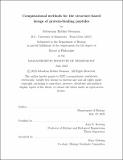| dc.contributor.advisor | Keating, Amy E. | |
| dc.contributor.author | Swanson, Sebastian Robles | |
| dc.date.accessioned | 2023-11-27T15:22:00Z | |
| dc.date.available | 2023-11-27T15:22:00Z | |
| dc.date.issued | 2023-06 | |
| dc.date.submitted | 2023-11-14T23:01:55.878Z | |
| dc.identifier.uri | https://hdl.handle.net/1721.1/153028 | |
| dc.description.abstract | The de novo design of peptides that bind to target proteins could enable binding to specific epitopes, inhibition of natural interactions, and targeted degradation of proteins. Despite advances in protein engineering, this remains a challenging task due to the large space of peptide structures and inaccuracies in atomic energy functions. In this thesis, I introduce new computational methods for structure-based design using structural motifs from the Protein Data Bank (PDB). To sample peptide structures in the context of a target protein, I mine tertiary motifs from known structures in the PDB to identify surface-complementing fragments or “seeds”. I show that TERM-based seeds can describe known binding structures with high resolution: the vast majority of peptide binders from a non-redundant set of 486 peptide-protein complexes can be covered by seeds. Furthermore, I demonstrate that known peptide structures can be reconstructed with high accuracy from peptide-covering seeds. I develop two methods for combining seeds to sample larger peptide backbone structures. The first method combines seeds that satisfy geometric overlap criteria and the second method identifies loop fragments from the PDB to join spatially proximal seeds. To score peptide structures, I develop statistical potentials that capture distinct features of their interface structures: sequence-structure compatibility and designability. Through a series of computational benchmarks, I show that the statistical potentials can be used to identify seeds predicted to form favorable interface structures. As proof of concept, I use the methods to design peptide binders of multiple target proteins, some of which have no known peptide binder. The designs are structurally diverse and have Rosetta energies that are comparable to natural peptides. For some of the peptides, I show that AlphaFold can accurately predict the designed structure. Altogether, this work demonstrates the potential of applying structural motifs to the design of protein-binding peptides and highlights important directions for future work. | |
| dc.publisher | Massachusetts Institute of Technology | |
| dc.rights | In Copyright - Educational Use Permitted | |
| dc.rights | Copyright retained by author(s) | |
| dc.rights.uri | https://rightsstatements.org/page/InC-EDU/1.0/ | |
| dc.title | Computational methods for the structure-based design of protein-binding peptides | |
| dc.type | Thesis | |
| dc.description.degree | Ph.D. | |
| dc.contributor.department | Massachusetts Institute of Technology. Department of Biology | |
| dc.identifier.orcid | 0000-0002-0114-0051 | |
| mit.thesis.degree | Doctoral | |
| thesis.degree.name | Doctor of Philosophy | |
